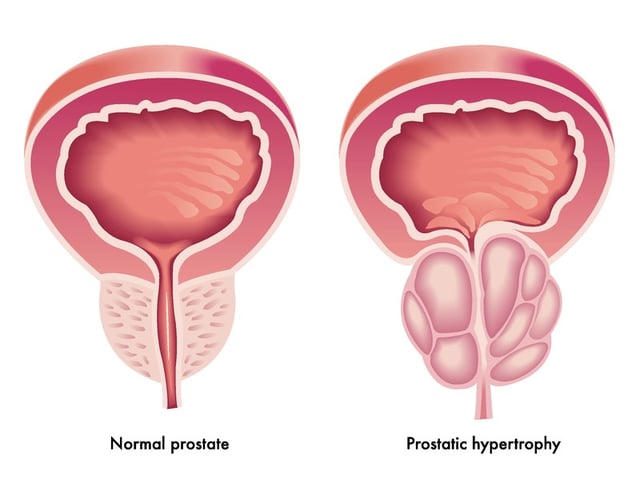One of the most prevalent prostate ailments in aging men is benign prostatic hyperplasia (BPH), also known as an enlarged prostate. Men over the age of 50 have a 50% chance of developing BPH, while 90% of men over 80 years of age have this problem. Urodynamics in benign prostatic hyperplasia (BPH) diagnosis will be discussed here.
What is Benign Prostatic Hyperplasia?
BPH is the clinical term for an enlarged prostate gland. The prostate gland is an important component for male reproduction and surrounds the urethra, which transports urine from the bladder outside the body. When the prostate gland is enlarged it can squeeze or partially block the urethra, causing difficulties with urination.

What are the Symptoms1 of Benign Prostatic Hyperplasia?
The most common symptoms of BPH include:
- Dribbling urine
- Difficulty starting a urine stream
- Frequent urge to urinate
- Weak urine stream
- Sensation that bladder has not been completely voided
- Bladder blockage
- Bladder infection
- Bladder stones
- Kidney damage
How is Benign Prostatic Hyperplasia Diagnosed?
To diagnose BPH, a complete a physical exam, including a digital rectal exam to feel the size of the patient’s prostate will be required. A urinalysis may be performed, as well as a prostate-specific antigen test to rule out prostate cancer. Urodynamics are also used in the diagnosis of an enlarged prostate.
How are Urodynamics Used in Benign Prostatic Hyperplasia Diagnosis?
Urodynamics testing involves a series of tests that measure the function of the lower urinary tract. If a patient is having difficulty voiding his bladder, urodynamics2 provide important data to better help make a diagnosis. Urodynamics is considered the gold standard for diagnosing disorders related to the bladder and urethra.
The first urodynamic test for BPH typically performed a urinary flow test. The flowrate of urine exiting the bladder will be determined in order to better understand whether the urethra is blocked due to an enlarged prostate. The patient should arrive to the appointment with a full bladder, and then pass urine into a flow meter. The instrument will provide immediate feedback indicating the velocity and pattern of the urine stream.
Immediately following the flow test is a bladder residual volume ultrasound, which determines how much, if any, urine is left in the bladder after voiding. Urine retained in the bladder can be a sign of an enlarged prostate obstructing urination. The volume of urine left behind can be indicative of other disorders, as well.
As part of urodynamics testing for BPH, cystometry is often performed. This test will determine the volume of urine the patient’s bladder can contain, how pressure fluctuates inside the bladder with increased urine volume, and how these factors affect the urge to urinate.
To perform cystometry tests a catheter is inserted through the urethra and into the patient’s bladder, while another tube is passed into the rectum to record changes in pressure. The catheter that was inserted into the bladder will be filled with sterile water or saline and used to refill the bladder, and the patient will be asked about the physical sensations he is experiencing. The patient will then be asked to void his bladder with the catheter in place while bladder pressure is measured. This test will determine whether there is an obstruction preventing the outflow of urine and if an enlarged prostate3 may be to blame.
What the Patient should Expect when Undergoing Urodynamics Testing
Urodynamics in Benign Prostatic Hyperplasia (BPH) is a useful tool for determining if an enlarged prostate is to blame for lower urinary tract issues. The patient should be reassured that these tests are painless, although he might feel discomfort in the form of pressure on your bladder and urethra. Urodynamics testing takes approximately 30 minutes to complete, and results will be made immediately available for consultation.
Are you interested in an easer way to do urodynamics? If so, click the button below.
If you liked this article, you might also be interested in our post on Urodynamics and Interstial Cystitis: http://info.bhnco.com/blog/urodynamics-and-interstitial-cystitis
References
- Clemens, J. Q. (n.d.). Urodynamics and the Evaluation of Male Lower Urinary Tract Symptoms. Management of Benign Prostatic Hypertrophy, 47-60. doi:10.1385/1-59259-644-4:47 Link
- Blaivas, J. G., & Tsui, J. F. (2012). Male lower urinary tract symptoms: The role of urodynamics. Urological Science, 23(1), 18-25. doi:10.1016/j.urols.2011.12.009 Link
- Roehrborn, C. G. (2005). Combination Medical Therapy for Lower Urinary Tract Symptoms and Benign Prostatic Hyperplasia. Reviews in Urology, 7(Suppl 8), S43–S51. Link


